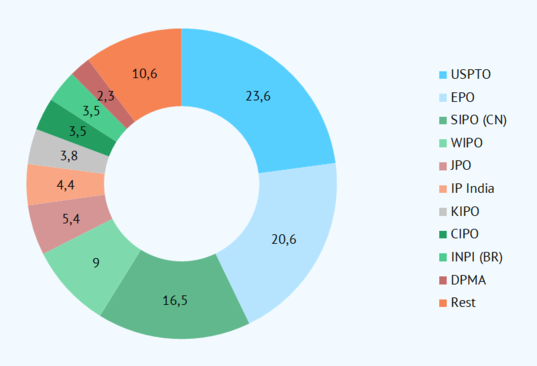Development of wind energy all over the globe continues at a steady pace and, according to the forecast of World Wind Energy Association, in 2015 total installed capacities will exceed 400 GW. China remains absolute leader in this process, with the USA and Germany coming after. However, markets are rapidly developing in other countries as well, particularly in India, United Kingdom and Brazil.
The present review evaluates the latest innovative solutions in the field of wind energy, which were described in patent applications published in 2015 in major patent offices of the world. In total, during the time period of interest we have found slightly over 3100 patent documents, which, to a greater or lesser degree, provide technical solutions on all aspects of wind energy – production and operation of turbines, blades, transmissions, electronic equipment, etc.
The majority of patent applications in 2015 was filed in the United States Patent and Trademark Office – 23.6%. European Patent Office and the State Intellectual Property Office of China are also among the leaders with 20.6% and 16.5% respectively. Below is provided the general picture of how inventors' interests are distributed among the 10 major patent offices of the world.
Distribution of documents by patent offices

USPTO - United States Patent and Trademark Office; EPO - European Patent Office; SIPO (CN) - State Intellectual Property Office, China; WIPO - World Intellectual Property Organization; JPO - Japan Patent Office; IP India - Intellectual Property India; KIPO - Korean Intellectual Property Office, South Korea; CIPO - Canadian Intellectual Property Office; INPI (BR) - National Institute of Industrial Property, Brazil; DPMA - German Patent and Trade Mark Office; Other - all other offices
By getting into the ten most popular patent offices among inventors, India and Brazil have substantiated the statuses of most attractive places for wind energy development in the emerging markets.
Below is provided a distribution of patent documents by the number of problems that, in accordance to the authors of documents, the proposed technical solutions are intended to solve.
The share of non-resident applicants in the filed documents has exceeded the share of residents more than twice. The most popular patent office among non-residents in 2015 was United States Patent and Trademark Office, followed by the patent offices of China, Europe, India, Canada and Brazil. In more than 2500 cases inventors proposed technical solutions in the form of new devices and as a new method in almost 2000 cases, while more than 30% of cases combined both device and method. New compositions are only proposed in 29 patent applications. The majority of newly proposed inventions complement the existing solutions that were previously described in earlier documents from the same patent family. The share of single patent documents comprised 11.6%. In most instances the proposed inventions correspond to subclass F03D of International patent classification, namely, wind turbines with rotation axis substantially parallel to the air flow and controlling thereof.
Distribution of documents by problems and rating points
| Problem groups | Number of documents in a group | Share of total, % | Rating of group dcuments |
|---|---|---|---|
| Administrative and organisational problems | 98 | 2.3 | 9.8 |
| Environmental and social impact | 231 | 5.5 | 8.8 |
| High CAPEX / Plant construction | 595 | 14.4 | 8.6 |
| High costs in general | 9 | 0.2 | 9.2 |
| High CAPEX / Equipment production | 397 | 9.4 | 9.1 |
| High OPEX / Operational maintenance | 619 | 14.4 | 8 |
| High OPEX / Repair and replacement | 1 209 | 28.7 | 9.1 |
| Low efficiency in general | 20 | 0.5 | 6.3 |
| Low kinetic-to-mechanical power conversion efficiency | 216 | 5.1 | 9.3 |
| Low mechanical-to-electric power conversion efficiency | 49 | 1.2 | 7.7 |
| Low efficiency caused by secondary natural factors | 307 | 7.3 | 9.8 |
| Low efficiency of secondary equipment | 354 | 8.4 | 9.1 |
| Low efficiency caused by wind variability | 96 | 2.3 | 9.5 |
| Unclear problem | 18 | 0.4 | 6.9 |
In approximately 1200 documents the authors concerned the issues of control systems and respective equipment, while in almost 850 documents another important wind turbine element was disclosed – blades. Other technology elements were mentioned less often.
The biggest interest of inventors was attracted by various problems of high costs of construction and operation of wind energy facilities, with high costs of equipment repair and replacement in the first place. To substantially lesser degree the technical solutions were dedicated to general operating efficiency of wind energy facilities.
For a detailed analysis of recent inventions and methodology of research in the field of wind energy and other important areas of contemporary power industry, please visit www.aenert.com
